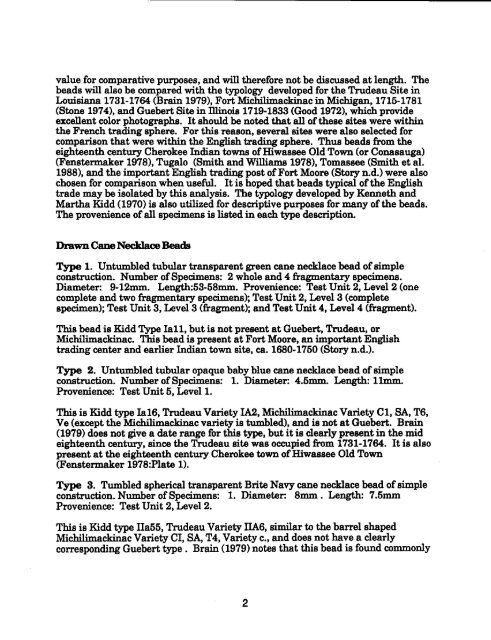Ye Pleasant Mount: 1989 1990 Excavations - Open site which ...
Ye Pleasant Mount: 1989 1990 Excavations - Open site which ...
Ye Pleasant Mount: 1989 1990 Excavations - Open site which ...
Create successful ePaper yourself
Turn your PDF publications into a flip-book with our unique Google optimized e-Paper software.
value for comparative purposes, and will therefore not be discussed at length. The<br />
beads will also be compared with the typology developed for the Trudeau Site in<br />
Louisiana 1731-1764 (Brain 1979), Fort Michilimackinac in Michigan, 1715-1781<br />
(Stone 1974), and Guebert Site in Dlinois 1719-1833 (Good 1972), <strong>which</strong> provide<br />
excellent color photographs. It should be noted that all ofthese <strong>site</strong>s were within<br />
the French trading sphere. For this reason, several <strong>site</strong>s were also selected for<br />
comparison that were within the English trading sphere. Thus beads from the<br />
eighteenth century Cherokee Indian towns ofHiwassee Old Town (or Conasauga)<br />
(Fenstermaker 1978), Tugalo (Smith and Williams 1978), Tomassee (Smith et al.<br />
1988), and the important English trading post ofFort Moore (Story n.d.) were also<br />
chosen for comparison when useful. Itis hoped that beads typical ofthe English<br />
trade may be isolated by this analysis. The typology developed by Kenneth and<br />
Martha Kidd (1970) is also utilized for descriptive purposes for many ofthe beads.<br />
The provenience ofall specimens is listed in each type description.<br />
DrawnCaneNecklace Beads<br />
Type 1. Untumbled tubular transparent green cane necklace bead ofsimple<br />
construction. Number ofSpecimens: 2 whole and 4 fragmentary specimens.<br />
Diameter: 9-12mm. Length:53-58mm. Provenience: Test Unit 2, Level 2 (one<br />
complete and two fragmentary specimens); Test Unit 2, Level 3 (complete<br />
specimen); Test Unit 3, Level 3 (fragment); and Test Unit 4, Level 4 (fragment).<br />
This bead is Kidd Type Iall, but is not present at Guebert, Trudeau, or<br />
Michilimackinac. This bead is present at Fort Moore, an important English<br />
trading center and earlier Indian town <strong>site</strong>, ca. 1680-1750 (Story n.d.).<br />
Type 2. Untumbled tubular opaque baby blue cane necklace bead ofsimple<br />
construction. Number ofSpecimens: 1. Diameter: 4.5mm. Length: 1lmm.<br />
Provenience: Test Unit 5, Levell.<br />
This is Kidd type la16, Trudeau Variety IA2, Michilimackinac Variety C1, SA, T6,<br />
Ve (except the Micbilirnackinac variety is tumbled), and is not at Guebert. Brain<br />
(1979) does not give a date range for this type, but it is clearly presentin the mid<br />
eighteenth century, since the Trudeau <strong>site</strong> was occupied from 1731-1764. Itis also<br />
present at the eighteenth century Cherokee town ofHiwassee Old Town<br />
(Fenstermaker 1978:Plate 1).<br />
Type 3. Tumbled spherical transparent Brite Navy cane necklace bead ofsimple<br />
construction. Number ofSpecimens: 1. Diameter: 8mm. Length: 7.5mm<br />
Provenience: Test Unit 2, Level 2.<br />
This is Kidd type IIa55, Trudeau Variety IIA6, similar to the barrel shaped<br />
Michilimackinac Variety CI, SA, T4, Variety c., and does not have a clearly<br />
corresponding Guebert type. Brain (1979) notes that this bead is found commonly<br />
2










